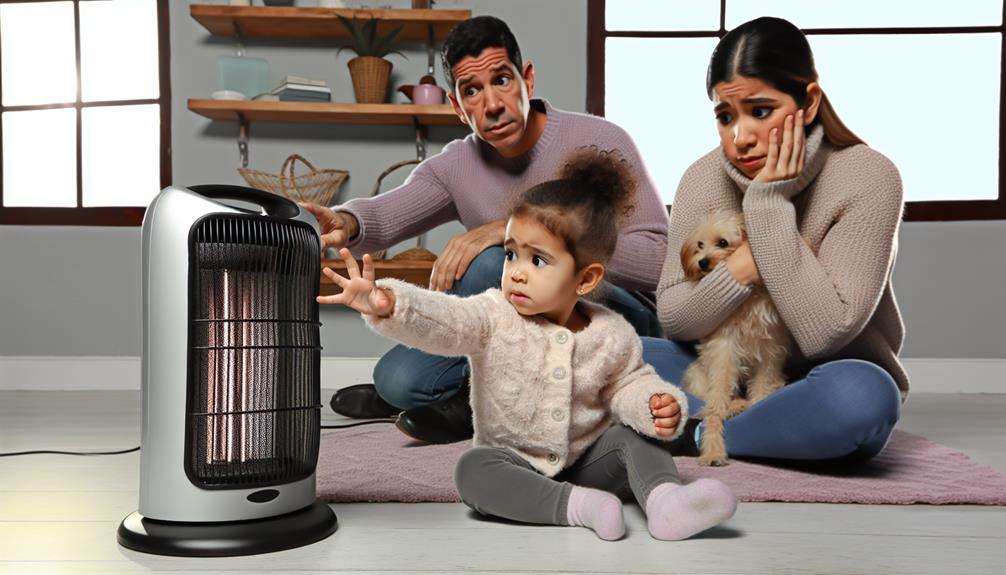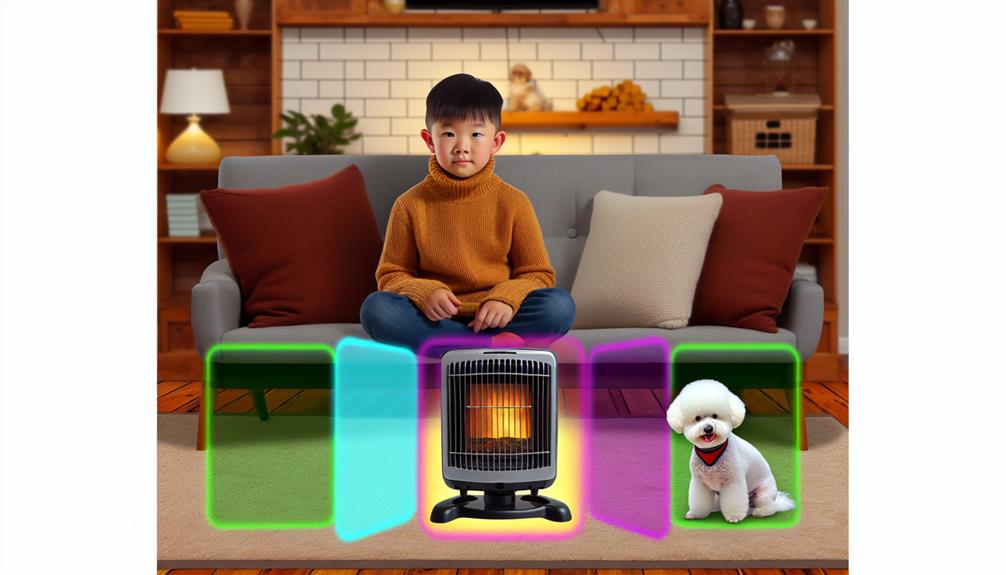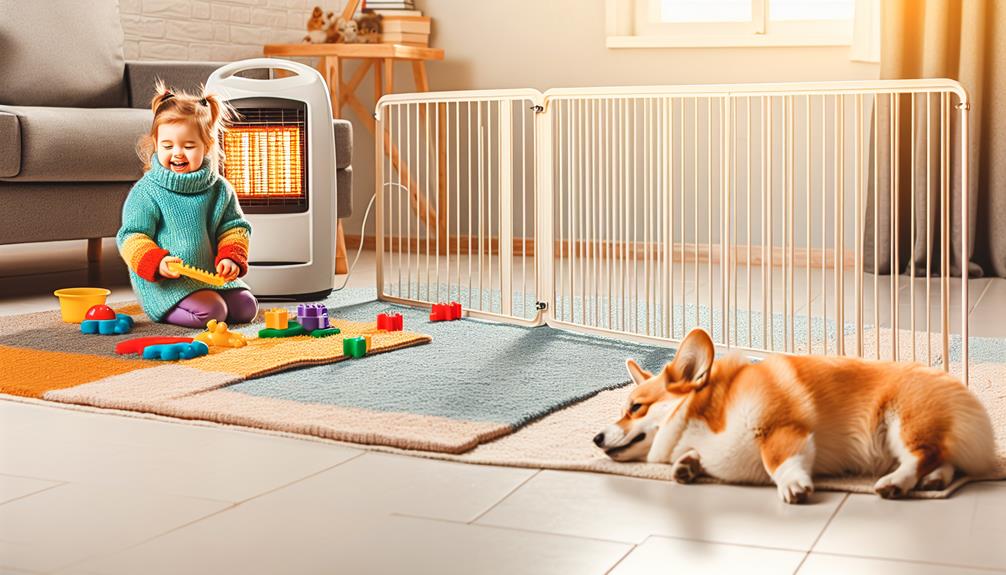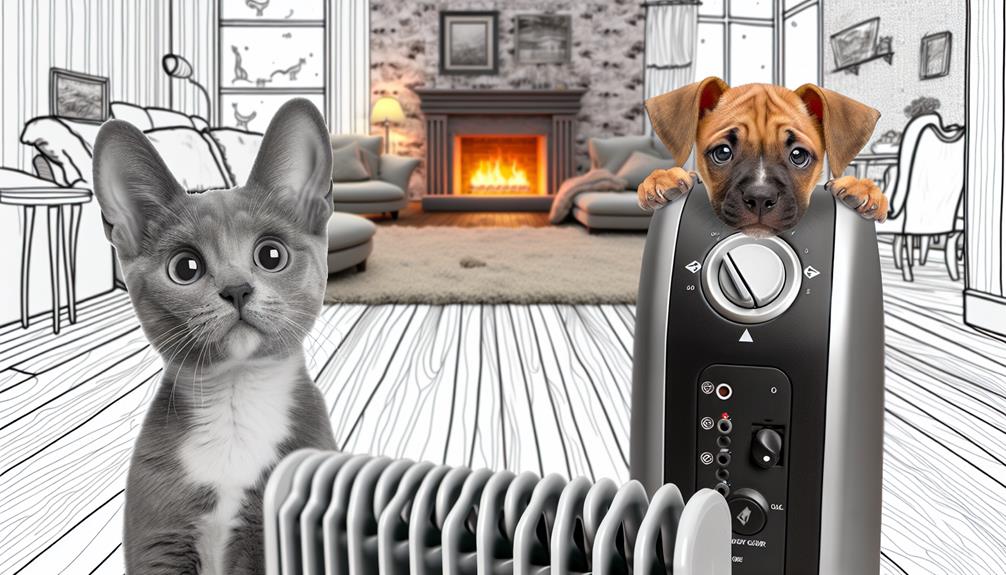You've researched, you've purchased, and you've positioned your portable heater to ward off the winter chill, but have you considered all the safety implications for your children and pets? As a parent, it's your responsibility to understand the hidden dangers that a seemingly harmless heat source can pose in your household. While portable heaters offer a convenient way to keep your family warm, without proper precautions, they can quickly become a hazard to curious toddlers and unsuspecting pets. You're about to discover the essential steps to ensure your little ones and furry friends remain safe and sound. What lies ahead is a guide that not only highlights the risks but also provides practical solutions that can seamlessly integrate into your daily routine, keeping your home warm and your loved ones secure.
Key Takeaways
- Choose a portable heater with safety features such as automatic shut-off, tip-over protection, and cool-to-touch exterior.
- Determine the appropriate heater size based on the square footage of the room to avoid excessive energy consumption and risks for children and pets.
- Consider energy-efficient heating options such as radiant panels, oil-filled radiators, and ceramic heaters with thermostat controls.
- Establish clear boundaries and safety zones around portable heaters, educate children and pets about the dangers, and consistently reinforce distance rules.
Understanding Portable Heater Risks

While portable heaters can warm up a room quickly, it's crucial to recognize that they also come with significant safety hazards that can't be overlooked. As a responsible parent, you need to be aware of the risks associated with these devices and how to mitigate them to ensure your family's safety.
Portable heaters are convenient, but they have been subject to recalls due to manufacturing defects that can pose fire hazards or lead to burns. It's your job to stay informed about heater recalls. Regularly check the Consumer Product Safety Commission (CPSC) website for updates and sign up for recall alerts on products you own. If your heater is recalled, follow the instructions provided, which typically involve returning the product or receiving a repair.
Burn treatment is a critical aspect of understanding portable heater risks. Children and pets are especially vulnerable to burns because they might not recognize a heater as a danger. To preemptively protect your loved ones, place heaters out of reach and teach children about the hazards. If an accidental burn does occur, it's essential to know the basics of burn treatment: cool the burn under running water, cover it with a sterile bandage, and seek medical attention for serious burns. Remember, applying ice or butter to a burn is a myth and can actually cause more damage.
Choosing the Right Heater
When selecting a portable heater, safety should be your top priority; look for models with automatic shut-off mechanisms and tip-over protection. You'll also need to consider the size of the space you're heating to ensure you choose a heater with the appropriate capacity. Lastly, opt for an energy-efficient model to keep your utility bills in check and reduce your environmental footprint.
Heater Safety Features
Ensuring your family's safety, it's crucial to select a portable heater equipped with advanced safety features. When you're shopping, keep an eye out for these must-have elements:
- Automatic shutoff: This mechanism kicks in when the heater gets too hot, preventing overheating and potential fire hazards.
- Tip-over switch: If your curious toddler or playful pet accidentally knocks the heater over, this feature cuts the power instantly to avert danger.
- Cool-to-touch exterior: Especially important with children and pets around, heaters with cool exteriors minimize the risk of burns upon contact.
- Overheat protection: In addition to automatic shutoff, this adds another layer of security by turning the heater off should the internal components reach unsafe temperatures.
Appropriate Heater Size
Selecting the right-sized portable heater for your space is as crucial as the safety features it offers, ensuring effective and efficient heating without excessive energy consumption. You'll find that heater types vary widely, from convection to radiant, and each has its own sizing guidelines. To make an informed choice, consider your room layout—measure the square footage to determine the wattage you'll need. Typically, a room requires 10 watts per square foot, meaning a 150-square-foot space would need a 1,500-watt heater. Avoid oversizing, as it not only wastes energy but also increases the risk for children and pets, with the heater potentially running too hot. Choose wisely to maintain a warm, safe environment for your family.
Energy-Efficient Heating Options
Having chosen a heater of the right size, it's equally important to consider energy efficiency to keep your heating costs down and reduce your environmental footprint. Here are four energy-efficient heating options that can provide both comfort and safety:
- Radiant Panels: These sleek devices emit heat directly to objects and people, rather than warming the air. They're highly efficient and can be wall-mounted to keep away from curious little hands and paws.
- Oil-filled Radiators: They retain heat well and can continue warming a room even after being switched off.
- Ceramic Heaters: Equipped with fans, they distribute heat quickly while often being lighter and cooler to the touch.
- Thermostat Controls: Look for heaters with adjustable thermostats to maintain a consistent temperature without overheating a room, ensuring both efficiency and safety.
Safe Heater Placement
When positioning a portable heater in your home, it's crucial to maintain a safe distance from any flammable materials to prevent potential fire hazards. Heater anchoring is an often-overlooked aspect that can significantly enhance the safety of your heater's operation. By securing the heater, you minimize the risk of it being knocked over by curious children or pets, which could lead to dangerous accidents. Choose a location for your heater where it can be anchored firmly, away from foot traffic to avoid trip hazards.
Moreover, it's essential to place the heater on a flat, level surface to prevent it from tipping over. Ensure it's not placed on furniture or elevated platforms where it's more susceptible to falls. Keep it at least three feet away from bedding, drapes, furniture, and other combustible materials. This clearance is non-negotiable as heaters can quickly ignite nearby fabrics or papers, leading to a rapid spread of fire.
Additionally, be mindful of the cord placement. The power cord should be routed in a manner that doesn't create a trip hazard, yet it should also remain unobstructed to avoid overheating or damage. Never run the cord under rugs or carpets, as this can fray the cord and lead to a fire risk.
Establishing Safety Boundaries

As a parent, it's crucial to define heater zones in your home to ensure your children's safety around portable heaters. You'll need to establish clear distance rules that your kids can easily understand and follow. Remember, setting these boundaries isn't just a suggestion—it's a vital step in preventing accidents and maintaining a safe environment.
Define Heater Zones
To ensure your child's safety, it's essential to establish heater zones by setting clear boundaries around portable heaters in your home. Heater etiquette not only includes the way the heater is used but also where it's placed. Zone mapping is a strategic way to define these areas, ensuring a safe environment for both children and pets. Consider these steps:
- Identify high-traffic areas and declare them heater-free zones.
- Choose a specific location for the heater that's away from flammable materials.
- Mark a perimeter of at least three feet around the heater as a no-go zone.
- Educate everyone in the household about these boundaries and the importance of respecting them.
Teach Distance Rules
You'll need to establish clear distance rules to keep your child safe around portable heaters, ensuring they understand the importance of keeping a safe space between them and the heat source. Heater guards can be instrumental in maintaining these boundaries, preventing direct contact with hot surfaces. It's essential to use visual cues that resonate with your child; colorful tape or mats can mark a 'no-go zone' around the heater. Consistently reinforcing these boundaries helps children remember to stay clear, even when you're not in the room. Additionally, explain the reasons behind these rules so they appreciate the danger, rather than seeing it as an arbitrary restriction. Safety is learned, so be patient and persistent in teaching these critical distance rules.
Supervision and Vigilance
Ensuring the safety of your children around portable heaters demands constant supervision and unwavering vigilance. As a parent, you're the first line of defense in accident prevention and child monitoring. It's imperative that you stay alert to the potential hazards that these heating devices pose. While they bring warmth and comfort, they also require your keen attention to ensure that curiosity doesn't lead to a dangerous situation.
To visualize your role, consider these key practices:
- Visual Contact: Always keep an eye on the heater when it's in use, especially if children are about. Whether you're doing chores or relaxing, make sure you can always see the heater and those near it.
- Physical Proximity: Stay within a safe distance to intervene if your child or pet gets too close. Your presence is a deterrent and a reminder of the boundaries you've set.
- Engagement: Engage with your children about the heater's risks regularly. Reinforce the rules and explain why they must not touch or play near it. Understanding leads to cooperation.
- Routine Checks: Periodically check on the heater to confirm it's functioning correctly and hasn't been tampered with. This also ensures it's not overheating or presenting a fire risk.
Heater Maintenance and Care

How often do you check your portable heater to ensure it's running safely and efficiently? Regular inspections are key to maintaining your heater's performance and, more importantly, the safety of your children and pets. It's not just about peace of mind; it's about preventing accidents before they happen.
The first step in heater maintenance is to inspect it before and after each use. Look for any signs of wear, damage, or loose components. If you notice anything amiss, it's time to repair or replace the unit. Don't take chances with the well-being of your family.
Dust accumulation is another concern that can't be overlooked. Heaters tend to attract dust and lint, which can not only diminish their efficiency but also pose a fire hazard. Every few weeks, or more often in dusty environments, unplug the heater and gently clean the exterior with a damp cloth. For the interior, check the manufacturer's instructions; some heaters have washable filters, while others require careful vacuuming or brushing.
Remember, a well-maintained heater is both more effective and safer. Keep cords untangled and away from high-traffic areas to prevent tripping or damage. When storing your heater, choose a dry, cool place away from children's reach.
Educating Children on Heater Safety
When it comes to heater safety, it's crucial to teach your children the do's and don'ts to prevent accidents and injuries. Your role as a parent is to instill heater etiquette from an early age, ensuring that your little ones understand the importance of accident prevention when using or being around portable heaters.
To create a clear picture in your mind, imagine these scenarios as a guide to discuss with your children:
- Respecting Boundaries: Picture your child playing a safe distance away from the heater, understanding that a no-go zone is set around it. This buffer zone is essential to prevent any accidental burns or the heater being knocked over.
- Touching Rules: Envision your child with their hands clasped together, resisting the urge to touch the heater. Children should know that heaters are not toys and that their hot surfaces can cause serious harm.
- Object Placement: Visualize your child carefully choosing where to place their toys, ensuring nothing is left near the heater. It's important to emphasize that objects should never be draped over or left close to the heater to avoid fire risks.
- Reporting Issues: See your child coming to you to report a strange smell or a strange noise from the heater. Encouraging them to speak up about any heater irregularities can be pivotal in accident prevention.
Protecting Pets From Heaters

Just as you teach your children about heater safety, it's equally important to consider your furry friends and the potential hazards that portable heaters can pose to them. Pets, with their innate curiosity and lack of awareness about the dangers of heat sources, can easily get too close to a heater, resulting in burns or other injuries. To mitigate these risks, pet proofing strategies are essential in any home that uses portable heaters.
Firstly, always place heaters in a location where pets cannot knock them over or touch hot surfaces. Use barriers or pet gates if necessary to maintain a safe distance. Moreover, never leave heaters unattended when pets are around. If you must leave the room, it's safer to turn the heater off.
To further protect your pets, consider heaters with features such as automatic shut-off when tipped over or cool-to-the-touch exteriors. These features can provide an extra layer of safety in case your pet comes into contact with the heater.
Should an accident occur, knowing basic burn treatment is crucial. If you suspect your pet has been burned, it's important to act quickly but calmly. Remove them from the heat source immediately and cool the affected area with lukewarm water—never ice, as this can worsen the burn. After initial first aid, seek veterinary care promptly to ensure proper treatment and prevent infection.
Emergency Preparedness and Response
In the face of heating emergencies, it's essential that you're equipped with the knowledge and tools for a swift and effective response. Disaster drills and emergency kits are critical components of your preparedness plan. You can't predict when a heater may malfunction or a power outage may occur, but you can ensure your family's safety with a proactive approach.
Here's what you need to do:
- Conduct Regular Disaster Drills: Familiarize each family member with a clear exit strategy. This means practicing escape routes and meeting points to reduce panic during an actual emergency. Make it a routine – just like a school fire drill, the repetition will engrain the process in everyone's minds.
- Prepare Emergency Kits: Your kits should be accessible and stocked with necessities. Items include a first-aid kit, flashlight, batteries, blankets, and a portable radio. Don't forget to include essential items for your pets, such as food, water, and a leash.
- Educate Your Children: Kids need to understand the importance of heater safety. Teach them what to do in case of a heater-related emergency, such as not touching or moving a fallen heater and alerting an adult immediately.
- Know Your Equipment: Regularly inspect your portable heaters for damage or wear and tear. Ensure they have automatic shut-off features and are certified by a recognized safety testing laboratory.
Your role as a parent includes ensuring that every member of your household, pets included, knows how to react if a heating emergency arises. Be informed, stay practical, and maintain an authoritative stance on safety. Your proactive measures will create a safer environment for your loved ones.
Frequently Asked Questions
How Can I Ensure My Child's Safety With a Portable Heater if They Have Respiratory Issues or Allergies?
To keep your child's allergies or respiratory issues from flaring up, it's crucial to pick a heater with respiratory friendly features, like a built-in air purifier. Allergy safe practices include regular cleaning of filters and choosing models that minimize dust circulation. Ensure the room's well-ventilated and the heater's out of reach. Remember, it's better to be safe than sorry when it comes to your little one's health.
Are There Any Portable Heater Models That Come With Child-Proof Controls to Prevent Tampering?
Yes, there are portable heater models with child-proof controls to prevent tampering. You'll want to look for units with safety certifications like UL or ETL. This ensures they meet strict safety standards. Also, consider heater placement; it should be out of reach to avoid accidents. Always read the manual for specific safety features and follow the manufacturer's guidelines to maintain a safe environment for your family.
Can Essential Oils or Other Fragrances Be Safely Used Around Portable Heaters Without Risking Air Quality for Children and Pets?
You can use essential oils around heaters, but it's crucial to ensure proper fragrance placement—away from the heater to avoid degrading air quality. Always prioritize heater maintenance, keeping devices clean and functioning well to mitigate risks. It's important to follow manufacturer guidelines for safe usage, especially in spaces shared with kids and pets. Remember, safety comes first when introducing any scent products into a home with portable heating units.
How Do the Noise Levels of Portable Heaters Affect Children's Sleep, and Are There Quieter Options Available?
Imagine lying in bed, a soft hum disrupting the silence as you try to drift off. Noise from portable heaters can cause sleep disturbance, especially for kids. Fortunately, you'll find quiet models on the market designed to minimize disruption. When you're shopping, look for heaters with low decibel ratings and features like 'silent operation' to ensure your child's sleep remains peaceful and undisturbed through the night.
What Should I Do if My Pet Has a History of Chewing Cords, in Respect to Safely Using a Portable Heater?
If your pet tends to chew cords, you must prioritize cord safety with portable heaters. Invest in robust cord concealment solutions to block access, and apply chew deterrents to discourage this dangerous habit. Ensuring the cord isn't a tempting target is critical for your pet's safety and the prevention of potential fire hazards. Always keep an eye on both the heater and your pet to mitigate any risks.
